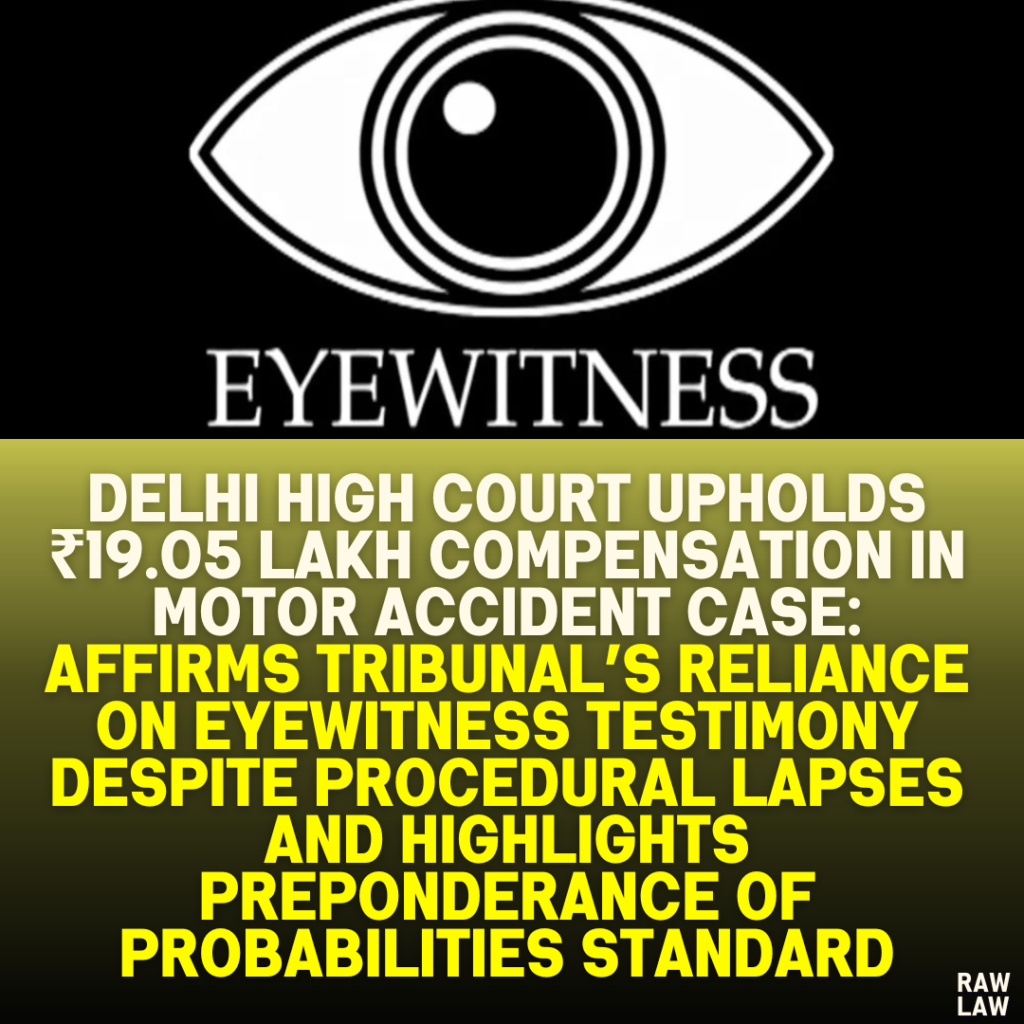Court’s Decision
The Delhi High Court dismissed the appeal filed by the Insurance Company against the Motor Accidents Claims Tribunal (MACT) award of ₹19,05,000 with 8% interest, granted as compensation for the demise of the victim in a road accident. The court upheld the Tribunal’s findings that the accident was caused due to the rash and negligent driving of the offending vehicle and that the involvement of the vehicle was established beyond doubt.
Facts
- Incident: On March 18, 2015, the deceased was traveling on his motorcycle (registration no. UP-15-BC-7332) near Meerut when he was hit by a Maruti Zen car (registration no. UP-13-G-0175). The driver fled the scene.
- Investigation: An FIR was registered, and subsequent investigation led to the filing of a chargesheet against the car’s driver, Jai Singh.
- Tribunal Award: The Tribunal awarded ₹19,05,000 as compensation to the claimants based on evidence presented, including the testimony of an eyewitness, PW2/Ashok Kumar.
Issues
- Was the offending vehicle involved in the accident?
- Could the testimony of PW2, an eyewitness, be relied upon despite his absence in the police chargesheet?
Petitioner’s Arguments
The Insurance Company challenged the Tribunal’s findings on these grounds:
- Insufficient Evidence: The company argued that the evidence presented did not conclusively establish the involvement of the offending vehicle in the accident.
- Eyewitness Credibility: It contended that PW2’s testimony was unreliable since his name was not included in the chargesheet, and his statement was not recorded during the police investigation.
- Defective Investigation: The petitioner highlighted procedural flaws, such as the absence of a seizure memo for the motorcycle and inconsistencies in the investigation.
Respondent’s Arguments
The claimants countered these arguments:
- Credibility of PW2: They asserted that PW2’s testimony was clear and consistent, establishing the involvement of the offending vehicle and the negligence of its driver.
- Tribunal’s Findings: They argued that the Tribunal had correctly relied on PW2’s testimony and other circumstantial evidence.
Analysis of the Law
The court analyzed the case through the lens of the preponderance of probabilities, the standard of proof in civil matters:
- Standard of Proof: Unlike criminal cases, civil cases do not require proof beyond a reasonable doubt. Instead, evidence is assessed based on probabilities.
- Doctrine of Preponderance: The court reiterated that the Tribunal was justified in relying on the cumulative weight of the evidence, including the eyewitness testimony and the chargesheet.
Precedent Analysis
The court referred to several precedents:
- National Insurance Co. v. Pushpa Rana (2009 ACJ 287 Delhi):
- Filing of a chargesheet is sufficient to establish the negligence and involvement of the vehicle.
- United India Insurance Co. Ltd. v. Deepak Goel (2014):
- The doctrine of preponderance requires tribunals to apply a basic test of evidence sufficiency but does not demand the stringent standard required in criminal cases.
- Jamanti Devi v. Maheshwar Rai (2022):
- Supported reliance on chargesheet and consistent testimony as indicators of liability.
Court’s Reasoning
- Credibility of PW2:
- The court found PW2’s testimony reliable and cogent. His statement, though not recorded in the police chargesheet, remained consistent during cross-examination.
- The absence of PW2’s name in the chargesheet was attributed to procedural lapses by the Investigating Officer (IO) and did not discredit his evidence.
- Chargesheet Evidence:
- The chargesheet filed against the vehicle’s driver and corroborating evidence provided by PW2 and others demonstrated the vehicle’s involvement.
- Failure of the Driver to Testify:
- The driver, Jai Singh, did not step into the witness box to rebut the allegations, further strengthening the claimants’ case.
- Negligence Proven:
- The court emphasized that rash and negligent driving by the driver of the offending vehicle was established through the evidence.
Conclusion
The court dismissed the Insurance Company’s appeal, affirming the Tribunal’s award. It held that:
- The evidence on record sufficiently proved the vehicle’s involvement and the driver’s negligence.
- Procedural lapses in the investigation did not outweigh the credibility of the eyewitness and other evidence.
The court directed that the statutory deposit, if any, be returned to the Insurance Company as per the law.
Implications
- Credibility of Witnesses: The judgment underscores that procedural lapses in police investigations do not necessarily negate the reliability of eyewitness testimony.
- Preponderance Standard: It reinforces the principle that civil liability in motor accident cases is determined by a lower standard of proof, focusing on probabilities rather than certainties.




Pingback: Supreme Court Rules That "Suitability for Promotion Under 65% Quota Cannot Be Overridden by Merit List Placement" – Notional Promotion and Seniority Benefits Directed Without Back Wages - Raw Law
Pingback: Delhi High Court Dismisses Petition Challenging Adverse Remarks in APAR, Upholds Denial of Promotion for Operational Lapses and Non-Compliance with Guidelines - Raw Law